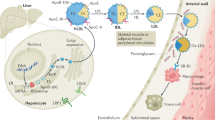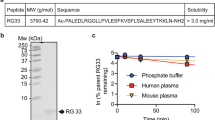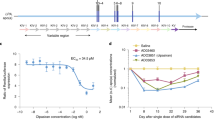Abstract
The importance of apolipoprotein A-I (apoA-I) in atherosclerosis was established by testing in animal models, and its potential usefulness in humans has been confirmed in preliminary studies. ApoA-I is a large protein comprising 243 amino acids, which means that venous administration is necessary. In addition, manufacture of apoA-I is difficult and expensive. Research has, therefore, been directed towards finding smaller peptide mimetics that produce similar results to apoA-I, but that are easier to manufacture and administer. The earliest peptides mimicked some of the lipid-binding properties of apoA-I but did not prevent atherosclerosis in mice. A detailed study of the physical–chemical characteristics of these peptides led to the realization that the hydrophobic region of the peptide was critical in determining bioactivity. A potent peptide, 4F, which was synthesized wholly from D-amino acids, could be given orally. Use of 4F significantly improved the function of HDL in mice and monkeys. When 4F was administered in combination with a statin, lesion size and macrophage content were reduced in mice with atherosclerosis, and lesions regressed in older mice. Vasoreactivity and endothelial sloughing were also improved in other rodent studies. Early human clinical trials are now being carried out on 4F. Here, we review the studies on apoA-I mimetic peptides that have been carried out so far.
Key Points
-
A potent apolipoprotein A-I mimetic peptide, 4F, that could be given orally was synthesized wholly from D-amino acids
-
Use of 4F significantly improved the function of HDL in mice and monkeys
-
When administered in combination with a statin, atherosclerotic lesion size and macrophage content were reduced in mice and lesions regressed in older mice
-
Vasoreactivity and endothelial sloughing were improved in a rat model of diabetes
-
Early human clinical trials are in progress using D-4F
This is a preview of subscription content, access via your institution
Access options
Subscribe to this journal
Receive 12 print issues and online access
$209.00 per year
only $17.42 per issue
Buy this article
- Purchase on Springer Link
- Instant access to full article PDF
Prices may be subject to local taxes which are calculated during checkout

Similar content being viewed by others
References
Badimon JJ et al. (1990) Regression of atherosclerotic lesions by high density lipoprotein plasma fraction in the cholesterol-fed rabbit. J Clin Invest 85: 1234–1241
Plump AS et al. (1994) Human apolipoprotein A-I gene expression increases high density lipoprotein and suppresses atherosclerosis in the apolipoprotein E-deficient mouse. Proc Natl Acad Sci USA 91: 9607–9611
Chiesa G and Sirtori CR (2002) Use of recombinant apolipoproteins in vascular diseases: the case of apoA-I. Curr Opin Investig Drugs 3: 420–426
Nanjee MN et al. (1999) Acute effects of intravenous infusion of apoA-I/phosphatidylcholine discs on plasma lipoproteins in humans. Arterioscler Thromb Vasc Biol 19: 979–989
Nanjee MN et al. (2001) Intravenous apoA-I/lecithin discs increase pre-β-HDL concentration in tissue fluid and stimulate reverse cholesterol transport in humans. J Lipid Res 42: 1586–1593
Kujiraoka T et al. (2003) Effects of intravenous apolipoprotein A-I/phosphatidylcholine discs on LCAT, PLTP, and CETP in plasma and peripheral lymph in humans. Arterioscler Thromb Vasc Biol 23: 1653–1659
Nissen SE et al. (2003) Effect of recombinant apoA-I Milano on coronary atherosclerosis in patients with acute coronary syndromes: a randomized controlled trial. JAMA 290: 2292–2300
Rader DJ (2003) High-density lipoproteins as an emerging therapeutic target for atherosclerosis. JAMA 290: 2322–2324
Zhang Y et al. (2003) Overexpression of apolipoprotein A-I promotes reverse transport of cholesterol from macrophages to feces in vivo. Circulation 108: 661–663
Barter PJ et al. (2004) Anti-inflammatory properties of HDL. Circ Res 95: 764–772
Navab M et al. (2000) Normal high density lipoprotein inhibits three steps in the formation of mildly oxidized low density lipoprotein: step 1. J Lipid Res 41: 1481–1494
Navab M et al. (2000) Normal high density lipoprotein inhibits three steps in the formation of mildly oxidized low density lipoprotein: steps 2 and 3. J Lipid Res 41: 1495–1508
Navab M et al. (2004) The oxidation hypothesis of atherogenesis: the role of oxidized phospholipids and HDL. J Lipid Res 45: 993–1007
Navab M et al. (1997) Mildly oxidized LDL induces an increased apolipoprotein J/paraoxonase ratio. J Clin Invest 99: 2005–2019
Navab M et al. (2005) An oral apoJ peptide renders HDL anti-inflammatory in mice and monkeys and dramatically reduces atherosclerosis in apolipoprotein E-null mice. Arterioscler Thromb Vasc Biol 25: 1932–1937
Ansell BJ et al. (2003) Inflammatory/anti-inflammatory properties of high-density lipoprotein distinguish patients from control subjects better than high-density lipoprotein cholesterol levels and are favorably affected by simvastatin treatment. Circulation 108: 2751–2756
Berliner JA and Watson AD (2005) A role for oxidized phospholipids in atherosclerosis. N Engl J Med 353: 9–11
Tsimikas S et al. (2005) Oxidized phospholipids Lp(a) lipoprotein, and coronary artery disease. N Engl J Med 353: 46–57
Lusis AJ et al. (2004) Genetic basis of atherosclerosis: part I. Circulation 110: 1868–1873
Anantharamaiah GM et al. (1985) Studies of synthetic peptide analogs of amphipathic helix: structure of complexes with dimyristoyl phosphatidylcholine. J Biol Chem 260: 10248–10255
Anantharamaiah GM (1986) Synthetic peptide analogs of apolipoproteins. Methods Enzymol 128: 627–647
Yancey PG et al. (1995) Efflux of cellular cholesterol and phospholipid to lipid-free apolipoproteins and class A amphipathic peptides. Biochemistry 34: 7955–7965
Venkatachalapathi YV et al. (1993) Effect of end group blockage on the properties of a class A amphipathic helical peptide. Proteins 15: 349–359
Datta G et al. (2001) Effects of increasing hydrophobicity on the physical-chemical and biological properties of a class A amphipathic helical peptide. J Lipid Res 42: 1096–1104
Navab M et al. (2005) Apolipoprotein A-I mimetic peptides. Arterioscler Thromb Vasc Biol 25: 1325–1331
Reddy ST et al. (2006) Oral amphipathic peptides as therapeutic agents. Expert Opin Investig Drugs 15: 13–21
Tang C et al. (2006) Janus kinase 2 modulates the lipid-removing but not protein-stabilizing interactions of amphipathic helices with ABCA1. J Lipid Res 47: 107–114
Navab M et al. (2001) HDL and the inflammatory response induced by LDL-derived oxidized phospholipids. Arterioscler Thromb Vasc Biol 21: 481–488
Forte TM et al. (2002) Altered activities of anti-atherogenic enzymes LCAT, paraoxonase, and platelet activating factor acetylhydrolase in atherosclerosis-susceptible mice. J Lipid Res 43: 477–485
Van Lenten BJ et al. (2001) The role of high-density lipoproteins in oxidation and inflammation. Trends Cardiovasc Med 11: 155–161
Fogelman AM (2004) When good cholesterol goes bad. Nat Med 10: 902–903
Navab M et al. (2005) The role of high-density lipoprotein in inflammation. Trends Cardiovasc Med 15: 158–161
Navab M et al. (2005) The double jeopardy of HDL. Ann Med 37: 173–178
Nicholls SJ et al. (2005) Formation of dysfunctional high-density lipoprotein by myeloperoxidase. Trends Cardiovasc Med 15: 212–219
Ansell BJ et al. (2005) High-density lipoprotein function recent advances. J Am Coll Cardiol 46: 1792–1798
Moore RE et al. (2005) Increased atherosclerosis in mice lacking apolipoprotein A-I attributable to both impaired reverse cholesterol transport and increased inflammation. Circ Res 97: 763–771
Navab M et al. (2002) Oral administration of an apoA-I mimetic peptide synthesized from D-amino acids dramatically reduces atherosclerosis in mice independent of plasma cholesterol. Circulation 105: 290–292
Van Lenten BJ et al. (2001) High-density lipoprotein loses its anti-inflammatory properties during acute influenza A infection. Circulation 103: 2283–2288
Van Lenten BJ et al. (2002) Influenza infection promotes macrophage traffic into arteries of mice that is prevented by D-4F, an apolipoprotein A-I mimetic peptide. Circulation 106: 1127–1132
Van Lenten BJ et al. (2004) D-4F, an apolipoprotein A-I mimetic peptide, inhibits the inflammatory response induced by influenza A infection of human type II pneumocytes. Circulation 110: 3252–3258
Srinivas RV et al. (1990) Antiviral effects of apolipoprotein A-I and its synthetic amphipathic peptide analogs. Virology 176: 48–57
Navab M et al. (2004) Oral D-4F causes formation of pre-β high-density lipoprotein and improves high-density lipoprotein-mediated cholesterol efflux and reverse cholesterol transport from macrophages in apolipoprotein E-null mice. Circulation 109: 3215–3220
Li X et al. (2004) Differential effects of apolipoprotein A-I mimetic peptide on evolving and established atherosclerosis in apolipoprotein E-null mice. Circulation 110: 1701–1705
Shah PK and Chyu KY (2005) Apolipoprotein A-I mimetic peptides: potential role in atherosclerosis management. Trends Cardiovasc Med 15: 291–296
Navab M et al. (2005) D-4F and statins synergize to render HDL anti-inflammatory in mice and monkeys and cause lesion regression in old apolipoprotein E-null mice. Arterioscler Thromb Vasc Biol 25: 1426–1432
Ou Z et al. (2003) L-4F, an apolipoprotein mimetic, restores nitric oxide and superoxide anion balance in low-density lipoprotein-treated endothelial cells. Circulation 107: 1520–1524
Ou J et al. (2003) L-4F, an apolipoprotein A-I mimetic, dramatically improves vasodilation in hypercholesterolemia and sickle cell disease. Circulation 107: 2337–2341
Ou J et al. (2005) Effects of D-4F on vasodilation and vessel wall thickness in hypercholesterolemic LDL receptor-null and LDL receptor/apolipoprotein A-I double-knockout mice on Western diet. Circ Res 97: 1190–1197
Navab M et al. (2005) An apolipoprotein A-I mimetic works best in the presence of apolipoprotein A-I. Circ Res 97: 1085–1086
Kruger AL et al. (2005) D-4F induces heme oxygenase-1 and extracellular superoxide dismutase, decreases endothelial cell sloughing, and improves vascular reactivity in rat model of diabetes. Circulation 111: 3126–3134
Duffy D and Rader DJ (2005) Drugs in development: targeting high-density lipoprotein metabolism and reverse cholesterol transport. Curr Opin Cardiol 20: 301–306
Linsel-Nitschke P and Tall AR (2005) HDL as a target in the treatment of atherosclerotic cardiovascular disease. Nat Rev Drug Discov 4: 193–205
Acknowledgements
This work was supported by NIH grants HL-30568 to AM Fogelman, HL-34343 to GM Anantharamaiah, and the Laubisch, Castera, and MK Grey Funds at UCLA to AM Fogelman.
Author information
Authors and Affiliations
Corresponding author
Ethics declarations
Competing interests
Mohamad Navab, GM Anantharamaiah and Srinivasa T Reddy are Principals and Alan M Fogelman is an Officer in BruinPharma, a start-up biotech company.
Rights and permissions
About this article
Cite this article
Navab, M., Anantharamaiah, G., Reddy, S. et al. Apolipoprotein A-I mimetic peptides and their role in atherosclerosis prevention. Nat Rev Cardiol 3, 540–547 (2006). https://doi.org/10.1038/ncpcardio0661
Received:
Accepted:
Issue Date:
DOI: https://doi.org/10.1038/ncpcardio0661
This article is cited by
-
Reconstituted Discoidal High-Density Lipoproteins: Bioinspired Nanodiscs with Many Unexpected Applications
Current Atherosclerosis Reports (2018)
-
Apolipoprotein A-I inhibits experimental colitis and colitis-propelled carcinogenesis
Oncogene (2016)
-
High-density lipoprotein in uremic patients: metabolism, impairment, and therapy
International Urology and Nephrology (2014)
-
Residual Cardiovascular Risk Despite Optimal LDL Cholesterol Reduction with Statins: The Evidence, Etiology, and Therapeutic Challenges
Current Atherosclerosis Reports (2012)
-
The Preventive Effects of Apolipoprotein Mimetic D-4F from Vibration Injury—Experiment in Rats
HAND (2011)



